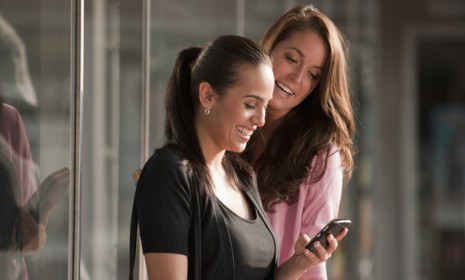Geofencing: Can texting save the brick-and-mortar retail industry?
Businesses are coming up with increasingly inventive ways to lure customers, and their latest innovation goes straight to your smartphone

The smartphone has become the bane of the retail industry, as savvy customers use physical stores to comparison-shop before going online on their phones to buy the same goods at a cheaper price, a practice known as showrooming. But brick-and-mortar stores are now fighting fire with fire, using smartphones to entice customers into their stores and make an immediate purchase. With the help of a new technology called geofencing, stores are sending texts to nearby customers and engaging with them on a more personal level. Here, a guide to the retail industry's new experiment with smartphones:
What is geofencing?
"The idea behind geofencing is to target customers when they are nearby," say Dana Mattioli and Miguel Bustillo at The Wall Street Journal. People who sign up for geofencing will receive texts from a store when they broach a certain radius, with the messages offering discounts and coupons that they wouldn't be able to find online. "The promotions can get hyper-local," say Mattioli and Bustillo, "like beaming a special on umbrellas to people within a 10-mile radius during a rainstorm."
The Week
Escape your echo chamber. Get the facts behind the news, plus analysis from multiple perspectives.

Sign up for The Week's Free Newsletters
From our morning news briefing to a weekly Good News Newsletter, get the best of The Week delivered directly to your inbox.
From our morning news briefing to a weekly Good News Newsletter, get the best of The Week delivered directly to your inbox.
Are many companies using the technology?
Big-time companies like The North Face, Starbucks, L'Oreal, and Kmart are giving it a whirl, says Chantal Tode at Mobile Commerce Daily. In addition, Apple and other smartphone makers are adding geofencing features to their handsets to alert users when they've entered a geofence.
How do customers feel about it?
One of the biggest challenges with geofencing is that customers "could feel that their privacy has been violated if offers suddenly begin appearing on their phone," says Tode. Furthermore, companies will have to do a better job knowing their customers, so that they can offer them deals on products they actually want. Companies also risk turning off customers with text "overload," says Rebecca Greenfield at The Atlantic. That being said, consumers are growing more accustomed to receiving text coupons, with more than 3.4 billion mobile coupons around the world redeemed in 2011.
A free daily email with the biggest news stories of the day – and the best features from TheWeek.com
How else is geofencing being used?
The potential is broad. Developers are looking beyond retail to see how geofencing — which is essentially a way for a phone to better recognize your physical location — can create "new systems that allow users to move more efficiently through their lives," says Steven James Snyder at TIME. Geofencing could be used, for instance, to alert your spouse when you're five minutes from home, or upload your patient history to hospital records when you enter an emergency room. The implications are profound, says Snyder.
Sources: MacWorld, Mobile Commerce Daily, TIME, The Wall Street Journal
-
 Political cartoons for November 15
Political cartoons for November 15Cartoons Saturday's political cartoons include cowardly congressmen, a Macy's parade monster, and more
-
 Massacre in the favela: Rio’s police take on the gangs
Massacre in the favela: Rio’s police take on the gangsIn the Spotlight The ‘defence operation’ killed 132 suspected gang members, but could spark ‘more hatred and revenge’
-
 The John Lewis ad: touching, or just weird?
The John Lewis ad: touching, or just weird?Talking Point This year’s festive offering is full of 1990s nostalgia – but are hedonistic raves really the spirit of Christmas?